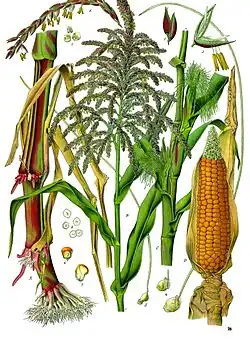玉蜀黍
Chinese
| jade | sorghum | ||
|---|---|---|---|
| trad. (玉蜀黍) | 玉 | 蜀黍 | |
| simp. #(玉蜀黍) | 玉 | 蜀黍 | |
Pronunciation
Synonyms
Dialectal synonyms of 玉米 (“corn; maize”) [map]
Descendants
Others:
Japanese
| Kanji in this term | ||
|---|---|---|
| 玉 | 蜀 | 黍 |
| とうもろこし | ||
| Grade: 1 | Hyōgaiji | Hyōgaiji |
| jukujikun | ||
Etymology
/taumorokoɕi/ → /tɔːmorokoɕi/ → /toːmorokoɕi/
Originally a compound of 唐 (tō, “Tang Dynasty; China in general; (by extension) foreign”) + もろこし (morokoshi, “sorghum”),[1] from the visual similarities between the sorghum and maize plants.
The spelling is jukujikun (熟字訓) from Chinese,[1] and appears to be a compound of 玉 (yù, “jade, jewel”) + 蜀黍 (shǔshǔ, “sorghum”, literally “Shu millet”). Compare modern Mandarin 玉蜀黍 (yùshǔshǔ, “maize”).
Usage notes
More common usage of the term is in katakana (トウモロコシ) or hiragana (とうもろこし) and perhaps never in kanji (玉蜀黍). For loose-kernel corn, the more common term in Japanese is コーン (kōn).
References
- Shōgaku Tosho (1988) 国語大辞典(新装版) [Unabridged Dictionary of Japanese (Revised Edition)] (in Japanese), Tōkyō: Shogakukan, →ISBN
- Matsumura, Akira, editor (2006), 大辞林 [Daijirin] (in Japanese), Third edition, Tōkyō: Sanseidō, →ISBN
This article is issued from Wiktionary. The text is licensed under Creative Commons - Attribution - Sharealike. Additional terms may apply for the media files.
